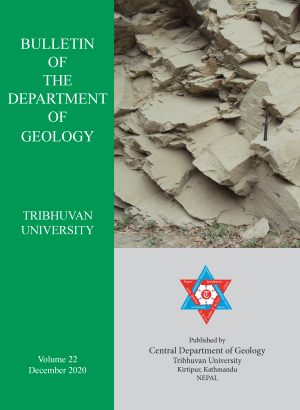Precise Location and Mapping of the Main Central Thrust Zone in Reference to Micro-Structures and Deformation along Khudi-Tal Area of Marsyangdi Valley
DOI:
https://doi.org/10.3126/bdg.v22i0.33414Keywords:
MCT zone, petrography, micro-structures, metamorphism, deformation, Marsyangdi valleyAbstract
Geological mapping was carried out along Marsyangdi valley in the Khudi - Dahare -Tal area on a scale of 1: 50,000 covering about 142 square kilometers. Recent study aims to locate the Main Central Thrust (MCT) precisely based on lithostratigraphy, micro-structures, deformation, and metamorphism. Several thin sections were observed to study the metamorphism, deformation, and micro-structures developed in the rocks. The rocks sequences in both the Higher Himalaya and the Lesser Himalaya have undergone polyphase metamorphism and deformation. The Lesser Himalaya experienced first burial metamorphism (M1) followed by garnet grade inverted metamorphism related to the MCT activity (M2) followed by retrograde metamorphism (M3) whereas the Higher Himalaya has undergone regional high-pressure/ high-temperature kyanite/ sillimanite- grade prograde regional metamorphism (M1) followed by the (M2) related to ductile sharing which in turn is overprinted by the later post-tectonic retrograde garnet to chlorite grade metamorphism during exhumation. The polyphase deformation is indicated by the cross-cutting foliation and many other features. The deformation phase D1 is associated with the development of the bedding parallel foliation due to burial in both the Higher Himalaya and the Lesser Himalaya. Isoclinal folds and crenulation cleavage were developed before the collision is categorized as D2. Development of nearly N- S trending mineral and stretching lineation, south vergent drag folds, folded S2 cleavage and microscopic shear sense indicators, rotated syn- tectonic garnet grains, etc. were developed during the deformation D3 related to the ductile shearing through the MCT. Various brittle faults and shear zones cross-cutting all earlier features were developed during D4 during the upheaval. The rocks in the MCT zone are affected by intense sharing and mylonitization as indicated by the presence of many mylonitic structures in the thin sections throughout the Lesser Himalaya in the area. Features like polygonization and ribbon quartz with evidence of sub-grain rotation, mica fish, syn-tectonic rotated garnet grains indicate the ductile shearing in the MCT area suggesting the dynamic recrystallization in the MCT zone whereas rocks of the Higher Himalaya show the evidence of recrystallization under static condition. The MCT zone was mapped precisely based on the microstructures and deformation.
Downloads
Downloads
Published
How to Cite
Issue
Section
License
© Central Department of Geology, Tribhuvan University, Nepal

